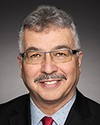Sorry for the interruption, but I'm afraid we're out of time on that one. Perhaps the answer could come as an adjunct to another question. Thank you.
The next question is from Niki Ashton, please.
Evidence of meeting #35 for Indigenous and Northern Affairs in the 42nd Parliament, 1st Session. (The original version is on Parliament’s site, as are the minutes.) The winning word was status.
A video is available from Parliament.
3:55 p.m.
Liberal

The Chair Liberal Andy Fillmore
Sorry for the interruption, but I'm afraid we're out of time on that one. Perhaps the answer could come as an adjunct to another question. Thank you.
The next question is from Niki Ashton, please.
3:55 p.m.
NDP

Niki Ashton NDP Churchill—Keewatinook Aski, MB
Thank you very much for being here today to speak to such an important piece of legislation. I'd like to begin by relaying concerns that I'm sure have come to your attention, concerns from the Assembly of First Nations from Quebec and Labrador, who wrote a letter to the Prime Minister at the end of October. They indicate:
The AFNQL considers that the provisions announced by [the] government in reaction to the Descheneaux decision contravene the obligation to properly consult with First Nations, which rests with the Crown.
They go on to say that the approach taken by the government “seems to us contradictory to the commitment of the present government to work in the context of a nation-to-nation relationship.”
As you probably know, they are highlighting the lack of consultation with communities. They are also highlighting the fact that many of the first nations that they represent hold the position that they, in fact, ought to be playing the role of recognizing who is or is not part of the nation. Clearly, the major piece is lack of consultation.
I know it came up from my colleague, as well, but I'm wondering if you have some concrete figures. How many first nations were consulted? How many people were consulted? Also, you may have heard from them not just on a nation-to-nation basis. I did hear the response earlier, but it was quite general, and I'd like to hear some figures on that front.
3:55 p.m.
Executive Director, Resolution and Individual Affairs Sector, Department of Indian Affairs and Northern Development
Building from Ms. McLeod's comment, too, we can provide you with information on paper, but just as an overview, we've had, to date, 11 sessions across Canada, with a variance of 50 to 150 participants. I hesitate to provide a ballpark number because people were coming in and out. Because of privacy issues, we don't collect direct information. A lot of these individuals were not registered members at that point. That is really our key target, as well: to register those who are unable to participate.
That said, we have had sessions across Canada, with sessions coming up in the two territories most impacted, Yukon and the Northwest Territories. We do have a chart with a breakdown of the numbers—and it's chief councillors registering administrators on the ground as well—which we're more than happy to submit to the committee for your reference.
3:55 p.m.
NDP

Niki Ashton NDP Churchill—Keewatinook Aski, MB
I appreciate, obviously, that for privacy reasons individuals may not want to be named, but I think what we're hearing here is that first nations feel as though they were not consulted. It would be important for us to hear which first nations you did hear. That kind of concrete information is critical for the work that we need to be doing here.
My next question relates to resources. In 2010, for example, with the changes at that time, many witnesses registered significant concern regarding the fact that proposed changes to membership were not accompanied by increased resources to process these changes. This is something that has been flagged by leaders in this go-round, as well. Is this something that is being dealt with by the government? Are resources being earmarked for first nations to deal with the processing at their end?
3:55 p.m.
Executive Director, Resolution and Individual Affairs Sector, Department of Indian Affairs and Northern Development
As my colleague was explaining, yes there are resources, and that was echoed again in the fiscal economic update. We took that into consideration in particular with the demographics and the cost of processing an individual application writ large, as well as the programming costs.
3:55 p.m.
NDP

Niki Ashton NDP Churchill—Keewatinook Aski, MB
That's more broad, but in terms of the figures, how much of that money would go to the first nations themselves is more the question that I'm asking.
3:55 p.m.
Executive Director, Resolution and Individual Affairs Sector, Department of Indian Affairs and Northern Development
Just with regard to programming and the numbers we've provided, there are two tranches of programming. There are those that are federally led programming for registration. Those are the two we talked about: the non-insured health benefit, as well as the post-secondary education.
The other programs are the residency-based on-reserve programming. Based on the demographics and the trends analysis that we've done, the impact will be quite minimal for those programs delivered on the ground based on residency. We do not see mobility on and off reserve to be quite large based on the 1996 census data, the 2011 household survey, and, of course, the implications and trends we saw with Bill C-3. It's been pretty stable at about 49%, 51%, and then 48%. It's really quite consistent. We're not anticipating a large impact on programming on reserve.
4 p.m.
NDP

Niki Ashton NDP Churchill—Keewatinook Aski, MB
Would it be possible to share more of that breakdown in terms of the on-reserve resources that are being allocated as a result?
4 p.m.
Executive Director, Resolution and Individual Affairs Sector, Department of Indian Affairs and Northern Development
Sure.
4 p.m.
NDP

Niki Ashton NDP Churchill—Keewatinook Aski, MB
To the first part of the answer, and obviously it was echoed in the presentation, we know that the 2% funding cap continues to be in place and results in existing inadequacies in terms of services and infrastructure on reserve. Obviously, we did hear about some of the funds that will be allocated as a result of this change in Bill S-3.
Given the fact that the 2% cap is still in place, do you perceive there to be a challenge when you are now admitting so many more people to the membership of communities when, in fact, ongoing services are already being frozen in terms of funding and don't reflect the current population numbers?
Perhaps you could speak to that tension that's emerging.
4 p.m.
Assistant Deputy Minister, Resolution and Individual Affairs Sector, Department of Indian Affairs and Northern Development
As my colleague mentioned, a lot of these programs, where you're referring to the 2% cap, are programs delivered on reserve that are residency based. We will be monitoring the trends as to whether this particular set of amendments will lead to an influx of population moving on reserve. Historically, that hasn't been the case.
Again, depending...37% of first nations control their own membership, so they get to decide whether or not these people also receive membership as a result of this. Registration is only one step. We will be monitoring this. At the moment we do not anticipate that this will put additional pressure on these limited resources, but over time we will be adjusting, if need be.
4 p.m.
Liberal

The Chair Liberal Andy Fillmore
Thank you. We're out of time, but that was well timed.
The next question is from Michael McLeod, please.
4 p.m.
Liberal

Michael McLeod Liberal Northwest Territories, NT
Thank you for your presentation. I have a couple of questions I want to ask.
I'm curious as to how far this goes back to correct all the different changes that were made over the years. Personally, in my family there were a lot of issues on registration, but that went way back when the script and the treaty were signed.
I've been approached by people in my riding on bringing this to justice, because a lot of decisions made at the time were influenced by the church, the people in Hudson's Bay, or fur traders as to who actually fit. Financial status was also considered. I have relatives who are status, and I have relatives who are not status. Some became status because of their gender. Some became status because of their financial state.
Now we're talking about reconciliation, but how far do we actually go to try to correct that? There were a lot of people who felt they should have been registered either through their local band council or band membership. Then there were others who felt they should have been registered as Métis. There are lots of questions, and there are a lot of people who were forced to register as Métis who feel they didn't cede or hadn't surrendered any rights to the land, but their great-grandfather got $100 or something, and that was it.
I think it's a question that's going to come up, and I'm curious as to how we'll deal with that, or are we even going that far back? Is there going to be a side table or other discussions on issues that are not obvious through this?
4:05 p.m.
Assistant Deputy Minister, Resolution and Individual Affairs Sector, Department of Indian Affairs and Northern Development
On that, yes, stage two of these initiatives will allow us to have a much broader discussion around all kinds of issues dealing with registration, membership, citizenship, and belonging to communities, so we'll do that.
In terms of your question as to how far back we go, it's quite complex. I'll ask Effie to speak briefly to the history and this balancing act that has been taking place over the course of these series of amendments to the Indian Act, and how far back we've gone so far.
4:05 p.m.
Effie Panousos Senior Policy Advisor and Manager, Treaties and Aboriginal Government Sector, Department of Indian Affairs and Northern Development
The first statute that appears in the history is in Upper and Lower Canada, pre-Confederation, in 1850. It was the first definition we saw of the concept of “Indian”. Also, it wasn't about the definition of an Indian. Those statutes were about protecting the land base, or essentially what we now call reserves.
The definition of Indian in pre-Confederation legislation that we saw in both Upper Canada and Lower Canada was very sex neutral. It was more akin to the rules or criteria that the first nations themselves had in defining who belonged to them and who didn't. That continued until about 1866 or 1867.
Post-Confederation, we see the first law, which was the gradual enfranchisement act of 1869, which basically establishes very patrilineal descent rules and sex-based criteria. It begins to exclude Métis, or those folks who identify as Métis, from registration. It continued that way basically until 1985 and over certain amendment periods. The Indian Act back then was being amended every two, three, or four years.
The 1951 Indian Act amendments were very comprehensive and they essentially established the system of registration as we know now, with an Indian registrar and status and non-status. Subsequent to that, the other reform that happened was in 1985, with the charter being in effect and trying to address all the inequities that flowed, essentially, beginning in 1869 through the Indian Act all the way to 1985. There were massive amendments in 1985. I don't think folks could foresee how the charter would operate vis-à-vis the Indian Act, because it was all new to everybody. Also, we had the constitutional amendments in 1982 that introduced Canada's recognition of aboriginal and treaty rights, so the interplay of registration membership, individual rights, and collective rights became a much more complex endeavour.
Just in respect of Métis, we anticipate under stage two that we will be speaking with Métis individuals and communities and the Métis nation around deregistration. As a result of the amendments that happened in 1985 and in 2010-11, a number of Métis individuals became eligible for registration and registered, but because the authority of the Indian registrar to unregister somebody was removed in 1985, they can't deregister and join their Métis collectivity, as is happening now in Alberta, Manitoba, and whatnot. That is one area we'll be looking at specific to the Métis situation, and we hope to be talking with Métis folks under stage two.
4:05 p.m.
Liberal

Michael McLeod Liberal Northwest Territories, NT
I want to point out that the Métis in the Northwest Territories are not represented by any national organization.
4:05 p.m.
Senior Policy Advisor and Manager, Treaties and Aboriginal Government Sector, Department of Indian Affairs and Northern Development
No.
4:05 p.m.
Liberal

Michael McLeod Liberal Northwest Territories, NT
If you need any help, I'd be glad to provide you with some contacts.
Bill C-31 allowed people to register, and most people anticipated that they would belong to a band and be part of a membership. However, for a lot of people it didn't happen. They ended up on a general list and didn't belong anywhere. Then they couldn't pull out. Is the issue of unregistering going to be looked at, also?
4:05 p.m.
Senior Policy Advisor and Manager, Treaties and Aboriginal Government Sector, Department of Indian Affairs and Northern Development
In relation to band membership?
4:05 p.m.
Liberal

Michael McLeod Liberal Northwest Territories, NT
We have a whole bunch of people who are registered as members. The issue of being registered as a status Indian could happen again. However, you can't join a band, so then a lot of times people realize that they don't want to categorized if they can't join.
4:05 p.m.
Senior Policy Advisor and Manager, Treaties and Aboriginal Government Sector, Department of Indian Affairs and Northern Development
No. That is a phenomenon that's happened since 1985, because before the 1985 amendments, eligibility for registration and eligibility for membership were one and the same.
4:10 p.m.
Liberal

The Chair Liberal Andy Fillmore
We'll have to leave it there, I'm afraid. Sorry about that.
We're moving into five-minute rounds of questions now.
The first five-minute round is coming from David Yurdiga.
November 21st, 2016 / 4:10 p.m.
Conservative

David Yurdiga Conservative Fort McMurray—Cold Lake, AB
Thank you to the panellists for taking our questions today.
I want to continue on with the line of questioning of my colleague Michael McLeod.
We see that Bill S-3 potentially guarantees Indian status, but it's not clear how it will encourage bands to include these people within their organization. Are there any programs or consultations planned to encourage these new members of first nations to be part of whatever band they are linked to?
4:10 p.m.
Assistant Deputy Minister, Resolution and Individual Affairs Sector, Department of Indian Affairs and Northern Development
Currently, 37% of all Indian Act bands are under section 10, so 37% control their own membership. They make their own decisions as to who is a member of their band. Registration under the Indian Act as Indian status does not necessarily give someone automatic membership into a band.
This is an amendment that was reintroduced in 1985, when first nations were able to re-take control over the determination of their own members. The government would not necessarily impose our views as to who they should or should not recognize as members of their band. With respect to all the other bands that continue to be under section 11, it's automatic. Indian registration will give you membership into the community that you belong to.
4:10 p.m.
Conservative

David Yurdiga Conservative Fort McMurray—Cold Lake, AB
Is there going to be money attached? Obviously, a lot of new first nations people are going to be moving onto a reserve. Is there going to be more money for housing and programming? Already, a lot of our budgets are stretched, and any more strain put on our budgets is not going to be a good situation. Can you comment on whether there's any funding? Is it a percentage? How are the numbers going to be calculated? I guess that would be a better way to ask.